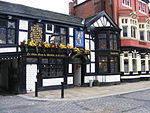St Peter's Church, Bolton
19th-century Church of England church buildingsBuildings and structures in BoltonChurch buildings by E. G. PaleyChurch of England church buildings in Greater ManchesterChurches completed in 1871 ... and 3 more
Grade II* listed churches in Greater ManchesterHistory of BoltonUse British English from September 2013

St Peter's Church, Bolton-le-Moors, commonly known as Bolton Parish Church, is a Church of England parish church in Bolton, Greater Manchester, England. The parish church, dedicated to St Peter, is an example of the Gothic Revival style. The church is recorded in the National Heritage List for England as a Grade II* listed building, having been designated in 1974. St Peter's is an active parish church in the Diocese of Manchester and is part of the Bolton deanery and Bolton archdeaconry.
Excerpt from the Wikipedia article St Peter's Church, Bolton (License: CC BY-SA 3.0, Authors, Images).St Peter's Church, Bolton
Church Bank,
Geographical coordinates (GPS) Address External links Nearby Places Show on map
Geographical coordinates (GPS)
| Latitude | Longitude |
|---|---|
| N 53.579 ° | E -2.423 ° |
Address
Bolton Parish Church
Church Bank
BL1 1HX , The Haulgh
England, United Kingdom
Open on Google Maps









